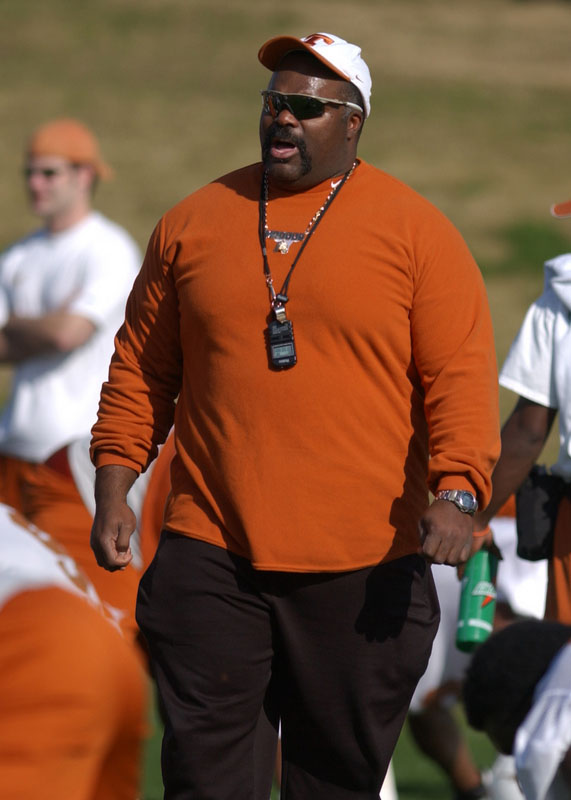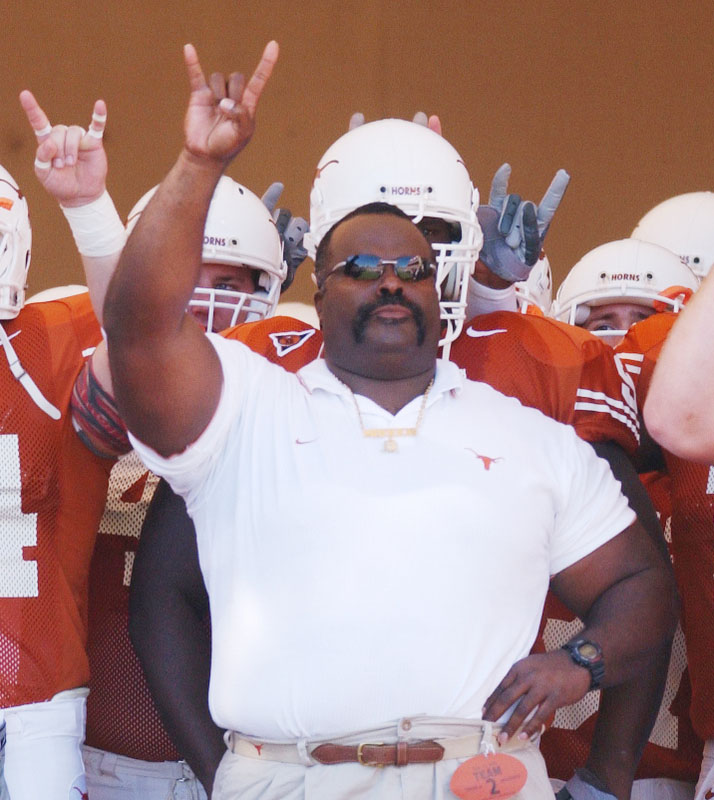Jeff Madden: Bio
Jeff “Mad Dog” Madden made quite the journey from his younger days in Cleveland, Ohio to becoming the Assistant Athletics Director for Strength and Conditioning at the University of Texas. When he was a boy, his father, Wayne, a Marine drill sergeant, would instruct Jeff to make his bed at in the morning followed by countless pushups and pull ups and sit ups. This “PT” eventually turned into an interest in strength and conditioning, which blossomed when he bought his first Joe Weider weight set and began to train in his basement.
Madden was given his nickname “Mad Dog” by his high school coach due to his aggressive and persevering nature. As a result, Madden earned All-American status at St. Joesph’s High School, located at Lakeshore Boulevard, just north of interstate 90 in Cleveland. After high school, Madden attended Vanderbilt University, where he earned a letter in football for three seasons. Madden graduated in 1983 with a degree in sociology along with a minor in psychology and secondary education. He then became a graduate assistant at the University of Cincinnati for the football team, specifically the offensive line, and was also the head strength and conditioning coach. During this time, Madden worked with the head coach, Watson Brown, Mack Brown’s older brother. After his spell at Cincinnati, Madden played football with the Memphis Showboats in the USFL. One year later, he was offered a matching salary, but to become the associate head strength and conditioning coach at Rice University under the guidance of Watson Brown. From there, Madden became the assistant athletics director of strength and conditioning for the University of Colorado, where he coached and trained two back-to-back national championship contending teams, with one national championship team in 1990, three-straight Big Eight championships, four bowl games, and one Heisman Trophy winner Rashaan Saalam.
In addition, he coached over 65 players who would go on to play professionally, several Pro-Bowlers, one Butkus award winner, one Thorpe award winner, countless All-Americans and 1st-round NFL draft picks, all at the University of Colorado. Madden then joined Mack Brown at North Carolina at Chapel Hill and became the associate head athletic director: head strength and conditioning coach. During his time at UNC, the football team went to six bowl games, and he coached over 70 NFL players. Finally, Madden went to the University of Texas with Mack Brown in 1998.
When Madden took over at UT in January of 1998, he soon helped re-design the Nasser Al-Rashid weight room, making this the fourth facility design of his coaching career. The facility encompasses 20,000 square feet of space with 900 square feet designated as a plyometric training area and another area dedicated to a three lane, 70 yard track. Madden outfitted the facility with the purpose of making it state of the art and providing the best opportunity for Texas athletes to optimize their performance.
Upon Madden’s initial hiring in 1998 as the assistant athletic director for strength and conditioning, he promised to emphasize speed and explosive power rather than solely brute strength. Madden’s philosophy was a result of his years of formulating track programs, his time playing at Vanderbilt, and his previous coaching days at Rice, Colorado, and UNC, in addition to his numerous certifications. These certifications include: A master certification in the National Association for Speed and Explosion, and also a master certification in International Sport Science. In addition, he has been selected as four-time National Strength Coach of the Year.
Some of Madden’s early work with UT athletes incorporated an aerobic base of fitness as the initial conditioning phase. Later, Madden shifted his athletes to interval training, ultimately having players progress from 4:1 rest to work ratios to a 1:1 rest to work ratio, in order to imitate the high-powered, fast-paced offenses in football. Madden used various instruments to achieve these results--such as weight vests, pulling parachutes, pushing and pulling sleds, hills and sand pits. Madden finally moved athletes into an over-speed phase, employing downhill running to improve both stride length and frequency. Due to these techniques, players became both faster and larger than they had ever been.
Madden also employed a Bulgarian wave system, focusing on the power clean. As a result of his rehabbing experiences in Cleveland, Madden believed that “Olympic lifting” movements could enhance an athlete’s performance. Yet Madden did not stray away from variation for his athletes. He exemplified this by his use of machines to correct imbalances and rehab injured athletes. Flexibility and hand-to-hand combat training were also programmed by Madden, simulating a more “sport specific” realm for his players during his off-season sessions. Madden believed that using these various means of training “helped translate during practice and helped football coaches see these differences for a more efficient athlete during the fall.”
These aforementioned strategies produced results in only a year’s time. From his initial hiring in 1998 to the end of the summer in 1999, there were more than forty UT football players with a vertical jump of at least 30 inches and more than twenty-two athletes who could bench press more than 400 lbs and squat at least 500 lbs. Additionally, Madden also saw Dan Neil’s school record in the power clean broken by four of his athletes by an average of twenty pounds. Madden was also astonished by the physical transformation of his later athletes. Madden recalls seeing athletes such as Colt McCoy going from a “168 pound boy to a 210 pound man.”
Additionally, Brian Orakpo looked like a “basketball player” when he reported at 207 pounds his freshman year, but transformed himself into a 264 pound NFL first round draft pick able to bench press 525 lbs.
One central tenet to Madden’s training was his focus on mental strength. According to Madden, “strength training is transforming boys to men and getting them tougher and preparing them for competition.” He also emphasized strength and conditioning as “team building,” and stated that it establishes “team camaraderie; attempting to get 120 football players going in one direction.”
Madden’s tough mental preparation along with his grueling physical training for his athletes led to his idea that “allowing kids to get stronger [helps] them gain confidence—and confidence produces winners.”
Madden is also a large advocate for helping athletes realize their life-long dream of becoming NFL players. During certain training weeks, he emulated NFL combine tests in order for the athletes to test better during the Longhorn Pro Day. Madden said this “kept the kids from getting false hope so they could truly become the best they can be.” As a result, Madden has contributed to the training of more than 235 NFL players, with 34 of those being drafted in the first round.
Madden’s strength and conditioning body of work led to a long list of accolades. Two of his players were Heisman Trophy winners – Rashaan Saalam in 1994 and Ricky Williams in 1998 – and two were up for the award, Vince Young in 2005 and Colt McCoy in 2008. Madden also played a role in National Championship seasons in 1990, 1991, and 2005, and helped the Longhorns reach the national championship game in 2009.
He has also contributed to the success of other sports such as track and field; sixteen track and field athletes competed in the Olympics while under Madden’s guidance. Overall, more than 40 athletes competed in various sport in the Olympics while under Madden's guidance. In 2003, Madden was inducted into the USA Strength and Conditioning Coaches Association hall of fame. In May of 2009, Madden was elected as president of the Collegiate Strength and Conditioning Coaches Association (CSCCa). He is among a small group of coaches that earned the title of Master Strength and Conditioning Coach, the highest honor that can be achieved by a strength and conditioning coach in the CSCCa. Other awards achieved by Madden include the National Collegiate Strength and Conditioning Coach of the year in 2004, and the Culligan Holiday Bowl’s Admiral U.S. Grant Sharp Trophy in 2000.
In 2011, Madden was promoted to Associate Athletics Director for Strength and Conditioning, and he is still the overseer to the entire sports department at the University of Texas, including 14 full-time and 10 part-time strength and conditioning coaches. His resume speaks for itself, but the athletes he has trained speak louder.
"I want to attribute all of my success to an outstanding group of assistant coaches, graduate assistants, and interns throughout my career." - Coach Jeff "Mad Dog" Madden



